
Mortellaro's Nursery
Shrubs, trees, ground covers, native plants, and seasonal color
Wholesale Only
Click on any of the alpha indexes below to view the corresponding lists of plants.
The default list is displayed alphabetically by common name for all plant types. You can view the plants by clicking on the Scientific Name or limit the plant type by using the drop down.
Plants actively being grown for the current season are shown -- selecting Discontinued Items will show plants we have offered in the past.
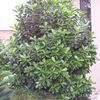
|
Viburnum, awabukiBotanical Name: Viburnum awabuki 'Chindo'
A native to South Korea, Awabuki is one of the fastest growing viburnums available. The leaves emerge light green, turning dark green and reaching up to eight inches long; they are very lustrous and have a leathery texture to them. It’s best to prune in late winter to promote even, uniform growth throughout the summer – it won’t hurt to prune the excessive growth midsummer to put another flush round of foliage before winter. Grows unchecked as a large shrub, but can easily be trimmed into a small, multi-branched tree with a natural round canopy. Fragrant white blooms appear in the late spring, leaving red berries soon after that turn black by the fall, attracting birds easily. As with all viburnums, it has some of the highest deer tolerance. Best grown in moist, fertile soils but can be forgiving of slightly less conditions. [ More Info ]
|
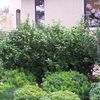
|
Viburnum, SuspensumBotanical Name: Viburnum suspensum
Native to Japan, the Sandankwa Viburnum is an excellent deer resistant shrub with an open spreading growth habit. Branches quickly grow out of the main shrub, but regular pruning will encourage a small, compact and full shape. Unpruned, it will grow ragged, reaching up to twelve feet tall and wide. The leaves start light green, but become dark green as they mature. They are oval-shaped with serrated edges, highly aromatic, and sometimes used in flower arrangements. Small tubular flowers are borne on the ends of new branches in the spring, and sporadically appear in the summer. They are white to pale pink, followed by small red berries in the fall that attract wildlife. Moist, well drained soils are highly recommended. [ More Info ]
|
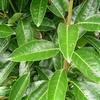
|
Viburnum, SweetBotanical Name: Viburnum odoratissimum
The Sweet Viburnum is an excellent large shrub or small tree native to Asia that has established itself in the Texan landscape. It is fast growing and relatively pest and disease free, and as a viburnum it’s as deer resistant as any plant can hope for. The smooth, leathery leaves can grow up to six inches long; they are dull green on one side and bright green on the other. In full sun, it creates a thick and lush shrub that is ideal for privacy screens or sound breaks along fence lines. In the shade it will not grow as robust, but slight pruning will encourage thicker growth. With only minimum pruning of lower branches, it easily forms into a small tree with a natural multi-trunked canopy. In the spring, tiny white flowers nearly cover the entire plant and are very fragrant, contributing to its name. Red drupe berries follow, turning black in the fall, attracting birds easily. [ More Info ]
|
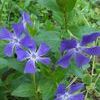
|
Vinca MajorBotanical Name: Vinca major
Vinca Major (Greater Periwinkle, Large Periwinkle, or Blue Buttons) is a widely used ground cover that, while not native to Texas, has become a popular choice for landscapes due to its vigorous spreading habit and adaptability. It features glossy green leaves and produces beautiful violet-blue flowers primarily in spring, with occasional blooms throughout the year in mild climates. It is ideal for erosion control, shady areas, and as a filler beneath trees and shrubs where turfgrass struggles. This plant thrives in partial to full shade and prefers moist, well-draining soil, though it is quite tolerant of drought once established. Vinca Major can adapt to a range of soil types, including both acidic and alkaline conditions. While it is generally not favored by deer, it is mildly toxic if ingested, making it important to consider for gardens with pets or small children. Vinca Major grows quickly, forming a dense, spreading mat that reaches about 6 to 12 inches in height. When planting for ground coverage, space plants 12 to 18 inches apart to ensure even growth. It can be aggressive in some areas, so occasional trimming may be necessary to maintain boundaries. This plant is evergreen in warmer regions of Texas but may experience some dieback in colder winters. It is hardy to USDA zones 6-10. In areas prone to frost, a layer of mulch can help protect the roots and encourage quicker regrowth in spring. [ More Info ]
|

|
Vinca PeriwinkleBotanical Name: Catharanthus roseus
2024 [ More Info ]
|
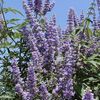
|
Vitex, Chaste TreeBotanical Name: Vitex agnus-castus
Vitex, also known as Chaste Tree, is a small deciduous ornamental tree that grows fairly fast and is tolerant of adverse environments such as heat, drought, high winds, and poor soil types. Although native to Europe and Asia, it has become naturalized in the southern states and used extensively. [ More Info ]
|
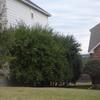
|
XylosmaBotanical Name: Xylosma congestum
Native to China, the Xylosma is an ideal selection for privacy screens, windbreaks, or foundation plantings as it grows wider than it gets tall. Commonly grown as a shrub, it can be pruned into a tree form. New foliage starts out red to bronze, then turns glossy green while on long, graceful arching stems. Xylosma isn’t susceptible to many plant diseases or pest. Inconspicuous yellow-green blooms appear in the early fall, but are followed by small black fruits that compliment the foliage well. Although evergreen, the Xylosma can drop leaves if exposed to freezing temperatures. [ More Info ]
|
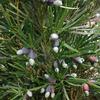
|
Yew, JapaneseBotanical Name: Podocarpus macrophyllus
Slow growing evergreen shrub native to Japan and southern China that has adapted well to the southern landscape. Naturally forms a conical to dome shape, and is commonly pruned into uniformed shapes for hedges, topiaries, or screens. The foliage is dark green and needlelike, whorled around the stems. Male plants have catkins that produce pollen. The females produce blue-green berries attached to attractive, yet mildly toxic, droop fruits that can be red, yellow, and dark purple. The Japanese Yew tolerates poor soil conditions as long as good drainage is provided. Japanese Yew grows well in the shade and sun, and can fit a variety of landscape needs when pruned into any form. [ More Info ]
|
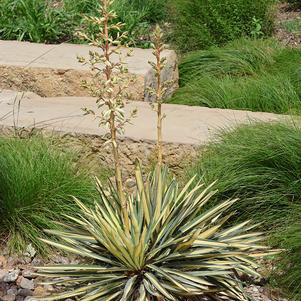
|
Yucca, Adam's Needle Leaf (Variegated)Botanical Name: Yucca filamentosa 'Variegata'
[ More Info ]
|
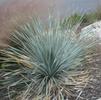
|
Yucca, Blue SotolBotanical Name: Dasylirion wheeleri
Blue Sotol (Dasylirion wheeleri), also known as Desert Spoon, is a striking plant native to the southwestern U.S. and northern Mexico – but not Texas. It forms a symmetrical rosette of slender, bluish-gray leaves with serrated edges, giving it a more dramatic, icy appearance compared to the green Dasylirion texanum. The stiff, arching leaves are topped with tall flower spikes in summer, attracting pollinators. This species thrives in well-draining, rocky soils and is highly drought tolerant, making it an excellent choice for arid landscapes, rock gardens, and desert-style plantings. Compared to Texas Sotol (Dasylirion texanum), Dasylirion wheeleri has a more pronounced blue-gray coloration and a slightly wider, more rigid leaf structure. While both species are heat and drought tolerant, D. wheeleri is more cold hardy, capable of withstanding temperatures down to USDA Zone 7. However, it is slightly slower growing than D. texanum and prefers drier conditions, making it better suited for West Texas and desert regions rather than humid areas. For best performance, plant Blue Sotol in full sun with well-drained soil, as it does not tolerate poor drainage. It will grow 3 to 4 feet tall and 4 to 6 feet wide, and if you plant a group then space them at least 4 to 6 feet apart to allow for their mature spread. While largely pest-free, occasional trimming of older leaves helps maintain its architectural form. [ More Info ]
|
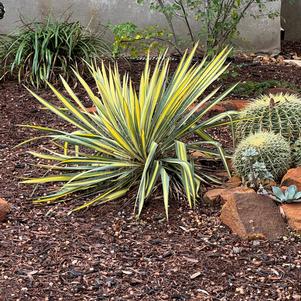
|
Yucca, Color GuardBotanical Name: Yucca filamentosa 'Color Guard'
Yucca 'Color Guard' is a vibrant, low-maintenance plant ideal for Texas landscapes. As a variegated cultivar of Adam's Needle (Yucca filamentosa), it stands out with sword-like leaves that feature striking yellow centers and green edges, unlike the solid green foliage of the species. This evergreen perennial adds year-round visual interest, growing to about 3-4 feet tall and wide. Adaptable and hardy, it thrives in full sun to partial shade, tolerates poor soils, and prefers alkaline, well-draining conditions common in many parts of Texas. In summer, 'Color Guard' produces dramatic flower spikes that rise 4-6 feet tall, adorned with creamy white, fragrant, bell-shaped blooms that attract pollinators like bees and butterflies. Its drought tolerance, deer resistance, and pest-free nature make it a reliable and low-maintenance option for Texas gardeners. Whether used in xeriscapes, borders, or rock gardens, its vibrant foliage provides a striking contrast to other plants, even during the winter months. This versatile yucca pairs beautifully with other drought-tolerant plants like agave, sedum, and ornamental grasses. It works well in both modern and traditional landscape designs, whether as a focal point or part of a mass planting. Combining resilience with striking aesthetics, Yucca 'Color Guard' is a standout choice for enhancing Texas landscapes. [ More Info ]
|
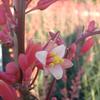
|
Yucca, RedBotanical Name: Hesperaloe parviflora
Despite its common name, Red Yucca (Hesperaloe parviflora) is not a true yucca but shares similar drought-tolerant characteristics. This Texas native is prized for its striking, arching foliage and tall flower spikes that produce coral-red, tubular blooms from spring through fall. These flowers are a favorite among hummingbirds and other pollinators. The plant’s evergreen, grass-like leaves have a fine texture and develop a slight curl along the edges, making it a visually interesting choice for xeriscapes, rock gardens, and mass plantings. Red Yucca is highly adaptable to Texas landscapes, tolerating extreme heat, drought, and poor soils. It thrives in full sun but can also perform well in part sun, though flowering may be reduced. It prefers well-draining soil and handles both rocky and sandy conditions with ease. While it is deer-resistant, occasional browsing may occur, especially in times of drought. This plant is also well-suited for use in borders, container plantings, and as an accent piece in desert or southwestern-style gardens. Compared to true yuccas like Yucca rostrata or Yucca recurvifolia, Red Yucca grows 2 to 3 feet tall, 3 to 4 feet wide. The bloom stalks will reach up to 5 feet. Plant them 3 to 4 feet apart to avoid crowding. Red Yucca has a softer appearance due to its finer foliage and more flexible leaves. Unlike many yuccas, it does not develop a tall trunk and instead forms a dense, clumping rosette. Its flowers also differ in shape, being slender and tubular, whereas most yuccas produce broader, bell-shaped blooms. While Dasylirion species (Sotols) share some similarities in leaf structure, Red Yucca’s flowering habit and overall growth form set it apart in the landscape. Red Yucca is highly cold-hardy, tolerating temperatures down to USDA Zone 5, making it an excellent choice for nearly all of Texas. It requires minimal winter care, though in extreme cold, mulching around the base can provide additional root protection. It does not require pruning, but spent flower stalks can be trimmed back in late winter to encourage fresh growth. [ More Info ]
|
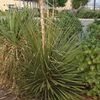
|
Yucca, SotolBotanical Name: Dasylirion texanum
Yucca Sotol, or Texas Sotol, is a hardy, drought-tolerant plant native to Texas and northern Mexico. This evergreen species forms a rosette of narrow, spiny-edged blue-green leaves that radiate symmetrically from a central trunk. Over time, it develops a short, woody base, adding a sculptural quality to the landscape. It thrives in full sun and well-drained, rocky, or sandy soils, making it an excellent choice for xeriscaping, desert gardens, and low-maintenance landscapes. In the summer, mature plants produce tall flower spikes that can reach up to 15 feet, covered in small, creamy-white blooms that attract pollinators such as bees and butterflies. Sotol itself can grow 3 to 4 feet tall and 4 to 6 feet wide. Not often planted together, but if one does, plant 4 to 6 feet apart. Texas Sotol is often used as a striking focal point, as a container specimen, or in mass plantings for a dramatic effect. Its tough, deer-resistant foliage ensures that it remains intact even in areas with heavy browsing pressure. Compared to its close relative, Dasylirion wheeleri (Blue Sotol), Texas Sotol has narrower leaves and a more compact form. While both species tolerate extreme heat and poor soil, Texas Sotol tends to be more cold-hardy and adaptable to various soil types, including limestone-based soils that are common in Texas. Its ability to withstand periods of heavy rain makes it a more resilient choice for regions that experience occasional flooding. Texas Sotol is highly cold-tolerant, withstanding temperatures down to 0°F once established. In areas prone to extreme winter freezes, providing well-draining soil is crucial to prevent root rot. It requires minimal care in winter, with no need for covering or extra protection. Pruning dead leaves or spent flower stalks in early spring can help maintain a clean appearance.
[ More Info ]
|
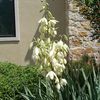
|
Yucca, WeepingBotanical Name: Yucca recurvifolia
Yucca recurvifolia, commonly known as Weeping Yucca or Soft Leaf Yucca, is a striking evergreen prized for its architectural form and adaptability to Texas landscapes. It features long, blue-green leaves that arch gracefully, giving it a softer appearance compared to other yuccas. This species is well-suited for xeriscaping, thriving in full sun to partial shade and tolerating a range of well-drained soils, from sandy to loamy. It is highly drought-tolerant once established and prefers neutral to slightly alkaline soils. One notable characteristic of the Weeping Yucca that we cultivate from root stock is its tendency to develop a more weeping leaf habit earlier in its lifespan compared to other specimens. This distinct trait enhances its ornamental appeal, making it an excellent choice for focal points in the landscape. In late spring to summer, mature plants may produce tall flower spikes adorned with creamy-white, bell-shaped blooms, which attract pollinators, including moths and hummingbirds. Unlike some yuccas that primarily propagate via offsets, Weeping Yucca can also produce seeds, though this is uncommon. Successful seed production requires pollination by specific yucca moths, which are not always present outside the plant’s native range. Due to this, commercial propagation and cultivation are typically done through root divisions or offsets rather than relying on seeds. The mature size typically reaches 4 to 6 feet in height with a similar spread. When planting for spacing, allow at least 3 to 4 feet between plants to accommodate their growth. It works well in mixed desert gardens, rock gardens, or as a specimen plant. Additionally, its fibrous leaves and tough structure make it deer-resistant, though caution should be taken as the leaf edges can be sharp. Although hardy to USDA zones 7–10, Weeping Yucca benefits from some winter protection in the colder parts of its range. It can tolerate brief cold snaps but may experience leaf damage in prolonged freezing conditions. Applying mulch around the base can help insulate the roots, and in extreme cold, wrapping the plant or providing overhead frost protection may be beneficial. [ More Info ]
|
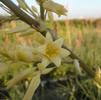
|
Yucca, Yellow BloomingBotanical Name: Hesperaloe parviflora
The Yellow-Flowering Red Yucca (Hesperaloe parviflora 'Yellow') is a rare color variant of the traditional Red Yucca, offering the same tough, drought-tolerant qualities but with striking yellow blooms instead of red. Just like its red-flowered counterpart, it thrives in full sun and well-drained soils, making it an excellent choice for Texas landscapes. This evergreen shrub forms an attractive clump of arching, blue-green foliage, and in warmer months, it sends up tall, 5-foot flower spikes that attract hummingbirds and pollinators. This yellow-blooming selection retains the same hardy, low-maintenance characteristics as the standard Red Yucca, tolerating heat, drought, and poor soils, as well as being highly deer-resistant. It grows to about 2 to 3 feet tall and spreads 3 to 4 feet wide, making it ideal for xeriscaping, rock gardens, and mass plantings. It prefers alkaline to neutral soils and thrives in USDA Zones 5-11. To preserve the purity of this yellow-blooming form, we have isolated these plants in a separate growing facility to prevent cross-pollination with traditional red-flowered Red Yucca. This ensures that they maintain their distinctive yellow color for future plantings. For mass plantings, space them 3 to 4 feet apart for best results. [ More Info ]
|
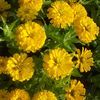
|
ZinniaBotanical Name: Zinnia elegans
Zinnia Dreamland Mix (Zinnia elegans) is a heat-tolerant, compact annual known for its large, double blooms in vibrant shades of pink, red, yellow, and orange. This variety is a standout choice for seasonal flower beds, borders, and container plantings, bringing continuous color from spring through frost. Unlike taller zinnias, the Dreamland Mix features short, sturdy stems that make it more resistant to wind and rain, making it an excellent choice for Texas gardens. Zinnias thrive in full sun and well-draining soil, preferring neutral to slightly acidic conditions. They are highly drought tolerant once established but benefit from regular watering to encourage extended blooming. Resistant to most pests and diseases, zinnias are also deer-resistant and attract butterflies, bees, and other pollinators. Dreamland Zinnias grow to a mature height of 10-14 inches with a spread of 8-12 inches, making them ideal for mass plantings, edging, and mixed flower beds. When planting in groups, space plants 8-12 inches apart for best coverage and airflow. Compared to other zinnia varieties, Dreamland Mix is bred for uniform growth and compact size, ensuring a well-balanced landscape display. In USDA Zones 9-11, zinnias can reseed and return the following year, though they are commonly treated as annuals in Texas gardens. Deadheading spent flowers encourages continuous blooming, extending their display deep into the season. These flowers thrive in hot, dry conditions, making them one of the best choices for Texas landscapes. [ More Info ]
|
